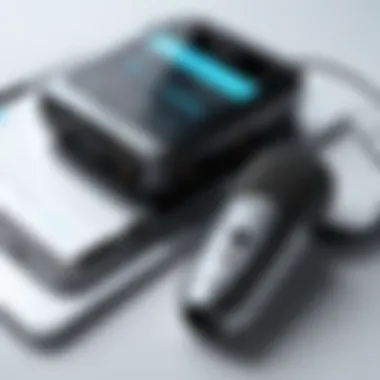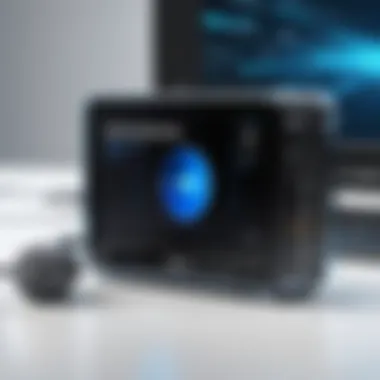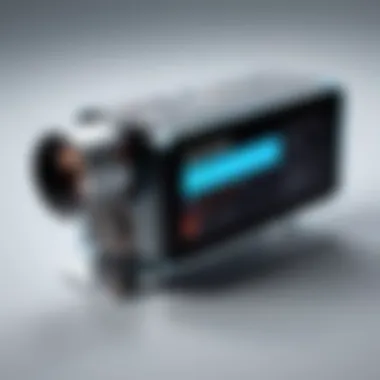Understanding 24 Hour Voice Recorders: A Comprehensive Exploration


Intro
The evolution of voice recording technology has significantly changed how individuals and organizations capture audio. Among the most innovative solutions are 24-hour voice recorders, which provide continuous recording capabilities for various applications. Their ability to capture hours of audio can be especially useful in contexts ranging from personal note-taking to corporate meetings.
These devices come in various forms, each suited for specific needs. Understanding their features, functionalities, and the underlying technology can aid information technology professionals in identifying the best solutions. This article explores the essential aspects of 24-hour voice recorders, focusing on their technical specifications and performance in real-world scenarios.
Product Overview
Key Features
24-hour voice recorders are equipped with several essential features that enhance usability:
- Continuous Recording: The primary feature allowing the device to capture audio around the clock.
- Storage Capacity: Many recorders come with substantial internal storage or support for external memory cards.
- Audio Quality: High-definition recording is often a standard feature, ensuring clear playback.
- Portability: These devices are usually compact, making them easy to carry.
- Battery Life: Extended battery life is crucial for all-day recording without interruptions.
Technical Specifications
The specifications can vary based on the model and brand. Key specifications to consider include:
- Recording Format: Common formats include WAV and MP3, impacting file size and quality.
- Sampling Rate: Higher rates provide better fidelity, with common rates being 44.1kHz or 48kHz.
- Connectivity Options: USB and Bluetooth connectivity can enhance functionality, allowing for easier data transfer and device control.
Performance Analysis
Benchmark Test Results
Benchmark tests provide insights into how 24-hour voice recorders perform under different conditions. The analysis often focuses on:
- Audio Clarity: Tests typically involve evaluating the clarity of recordings at varying distances from the microphone. Higher-end models tend to excel here.
- Battery Endurance: Longevity tests observe how long devices can record without depleting their batteries. Many models typically last beyond 24 hours in continuous recording mode.
- Storage Capacity: Evaluation of how much audio data can be recorded per gigabyte, a crucial metric for users with extensive recording needs.
Real-World Usage Scenarios
Understanding how these devices perform in practical settings is essential:
- Corporate Meetings: Businesses benefit from having a reliable device to record discussions, ensuring accurate documentation for future reference.
- Interviews: Journalists and researchers often rely on these devices to capture interviews, providing an accurate account of conversations.
- Personal Use: Individuals use voice recorders for personal notes or lectures, aiding retention and comprehension of information.
In essence, the versatility of 24-hour voice recorders positions them as invaluable tools in both personal and professional environments, making informed choices essential for prospective users.
By examining the features and performance of these devices, IT professionals can better navigate the options available to them, ultimately enhancing their recording practices.
Foreword to Hour Voice Recorders
In an age where capturing information efficiently is vital, 24 hour voice recorders play an essential role. These devices have emerged as tools that not only serve personal needs but also meet the demands of professional environments. Their capacity to record continuously provides an unparalleled advantage in various contexts. This includes everything from meetings and interviews to personal reminders. Understanding how these recorders work, their historical significance, and their technological advancements can greatly enhance their usability.
Defining Hour Voice Recorders
A 24 hour voice recorder refers to a device designed to capture audio continuously for an extended duration. These recorders are used in numerous settings, allowing users to document conversations, lectures, or crucial information without having to pause for manual operation. Features often include high storage capacity, advanced sound quality, and user-friendly interfaces. The continuous recording capability differentiates them from standard voice recorders, enabling users to gather data over longer periods. This makes them invaluable for both personal and professional uses, such as academic research or corporate discussions.
Historical Context and Evolution
The evolution of voice recording technology has been significant. Initially, audio recording was limited to analog methods, which required manual operation and had significant limitations in terms of sound quality and storage capacity. With the advent of digital technology, recording devices became smaller, more efficient, and offered higher sound fidelity. The transition to digital records has paved the way for the modern 24 hour voice recorder.
Today’s recorders are equipped with sophisticated features like noise reduction and cloud storage integration. This evolution has made voice recorders not only more accessible but also more reliable. The ongoing improvement of technology suggests that voice recorders will continue to adapt and meet the needs of an increasingly digital world.
"Understanding the journey of voice recorders helps us appreciate their significance in modern contexts."


Technical Specifications of Hour Voice Recorders
The section on technical specifications is central to understanding how 24-hour voice recorders function. It delves into the essential characteristics that define a recorder's performance and versatility. These specifications influence not only the usability of the device but also its effectiveness in capturing audio. Therefore, for IT professionals and tech enthusiasts, grasping these elements can guide choices suited to particular needs.
Storage Capacity and Recording Quality
When considering storage capacity, one must evaluate how much audio data can be stored without interruption. Generally, 24-hour voice recorders offer varied storage capacities, typically measured in gigabytes. For instance, a device with 8GB can hold approximately 144 hours of recording at standard quality. Higher capacities like 16GB or 32GB can extend this duration significantly, accommodating different recording needs.
Recording quality is equally important. This refers to the clarity and fidelity of the audio captured. Many modern recorders offer quality settings ranging from low to high, impacting both the file size and the audio's richness. A user intending to conduct interviews may prefer a high-quality setting for clearer dialogues, while casual users might opt for lower settings to save storage.
Battery Life and Power Sources
Battery life is a critical factor that affects the functionality of a 24-hour voice recorder. Devices can come with rechargeable lithium-ion batteries or use disposable AA batteries. A good recorder should offer at least 10 to 12 hours of continuous recording time on a single charge. However, some advanced models can provide upwards of 20 hours with power-saving modes activated.
Moreover, the choice of power source can influence usage scenarios. A recorder that can connect to power continuously is ideal for long-term monitoring. Users should also consider options for power backups to ensure uninterrupted operations, especially in professional settings where recording cannot be paused.
Connectivity Options
Connectivity options expand the versatility of 24-hour voice recorders significantly. Most devices now come with USB connectivity for transferring files to computers, enabling quick storage management. Some advanced models offer Bluetooth connectivity, facilitating wireless transfers and possibly even live streaming of recorded audio. This feature can be very helpful for tech-savvy users who need to integrate their recordings with various devices or applications.
In addition, integration with cloud services is becoming increasingly common. This enables automatic uploads and easy access to recordings from anywhere, adding another layer of convenience and security. Users should assess their connectivity requirements based on their intended application, ensuring that the chosen recorder meets both current and future needs.
"Understanding the technical specifications of your voice recorder can transform your recording experience, making it more effective and tailored to your specific requirements."
In summary, the technical specifications of 24-hour voice recorders play a pivotal role in determining their effectiveness and usability. By focusing on storage capacity, recording quality, battery life, and connectivity options, users can make informed decisions that align with their professional or personal needs.
Types of Hour Voice Recorders
Understanding the different types of 24-hour voice recorders is crucial for anyone looking to utilize this technology effectively. Each type offers unique features and benefits that cater to various needs and use cases. From professional settings to personal applications, selecting the right type is essential for optimizing their capabilities.
Analog vs. Digital Recorders
Analog voice recorders have been around for quite a long time. These recorders use magnetic tape to capture audio. The sound quality can vary, often compromised by background noise and degradation over time. However, many prefer analog for its simplicity and ease of use. They do not require batteries unless for a small power source. This makes analog devices incredibly reliable under various conditions, especially in professional environments where sound fidelity is critical.
On the other hand, digital recorders are significantly more advanced. They typically offer superior sound quality and storage options. With the ability to compress audio files, they provide more recording time without sacrificing clarity. Digital recorders also come with features like variable playback speed, built-in editing functions, and easy transfer to computers for archiving. This versatility makes them an excellent choice for IT professionals and tech enthusiasts who value functionality and efficiency in their recording devices.
Standalone vs. Smartphone-Compatible Devices
Standalone voice recorders are dedicated devices specifically designed for capturing audio. Their primary advantage lies in their focused design. Users appreciate the larger storage capacities and specialized features that enable extended recording times. Many standalone models come with superior microphones and noise-cancellation capabilities, essential for accurate recordings in noisy environments.
Smartphone-compatible devices, however, appeal to those who prioritize convenience. Many modern smartphones come with voice recording applications, which can be supplemented by external microphones for improved audio quality. This option is particularly useful for personal use or casual meetings where portability is essential. However, a consideration arises in terms of battery life and overall functionality when compared to specialized standalone devices.
Wearable Voice Recorders
Wearable voice recorders represent a growing trend in the audio recording landscape. These devices are designed to be discrete, allowing users to record conversations or lectures without drawing attention. Common examples include clip-on microphones or smartwatches with integrated recording features.
The primary advantage of wearable recorders is their mobility and ease of use. Users can move freely while capturing high-quality audio. This can be important for field research or personal note-taking, where written notes may not be practical. However, some users might find limitations in terms of storage capacity and battery life when compared to larger devices.
Applications of Hour Voice Recorders
The use of 24-hour voice recorders spans numerous domains, showcasing their versatility and efficiency. Their applications are extensive, ranging from professional environments to personal routines. Understanding how these recorders can be utilized helps in realizing the value they add to everyday life.
Professional Use Cases
Interviews and Meetings


In professional settings, recording interviews and meetings offers significant advantages. This application allows for an accurate account of conversations, ensuring that no critical information is lost. By capturing dialogue verbatim, voice recorders facilitate better follow-ups and decision-making.
The key characteristic here is reliability. A 24-hour voice recorder can document discussions without gaps, maintaining a complete record. This aspect is beneficial for professionals who need to refer back to discussions, especially in complex projects where details are paramount. The unique feature of continuous recording is particularly useful during lengthy meetings or interviews, which can sometimes yield unexpected insights that merit review.
However, there are challenges. Privacy concerns may arise, and not all parties may be comfortable with recording. Clear communication about the purpose and obtaining consent is critical to mitigate these issues.
Field Research
In the realm of research, particularly field studies, 24-hour voice recorders play an indispensable role. They allow researchers to collect qualitative data through interviews or spontaneous conversations that occur in natural settings. The immediacy of capturing data as it happens enriches the research findings.
The key characteristic of voice recorders in field research is their portability. Modern devices often come in compact designs, making them easy to carry during extensive fieldwork. This makes them a popular choice for academic and market research professionals alike. The continuous recording capability ensures that no vital moment is overlooked, providing a wealth of data to analyze later.
Nevertheless, researchers must abide by similar ethical standards concerning privacy as in other professional applications. Ensuring that participants are aware of being recorded is crucial in maintaining ethical research practices.
Personal Uses
Note-Taking
In personal settings, voice recorders have transformed the way individuals approach note-taking. Instead of writing, users can simply speak their thoughts or list reminders. For many, this method is quicker and more effective, especially during busy days when time is of the essence.
The key characteristic here is convenience. Voice recorders eliminate the need for manual writing, allowing for greater focus on verbal communication. This approach is noteworthy among students and professionals alike, offering a straightforward solution for recall and organizational tasks.
However, there are advantages and disadvantages. While speaking may be faster than writing for some, it can also lead to disorganized notes if not managed well. Efficient categorization post-recording is essential to maximize the benefits of this method.
Personal Reminders
Voice recorders are also invaluable for setting personal reminders. Users can record messages to themselves, ensuring they do not forget important tasks or appointments. This application is particularly effective for busy individuals who juggle multiple obligations.
The major characteristic of this usage is immediacy. People can quickly document reminders without pulling out a pen or access a digital device. This ease of use makes it a popular choice for managing daily responsibilities. A unique feature here is the ability to hear one’s voice, which serves as a personal motivator.
However, like any tool, personal reminders may experience some drawbacks. Over-reliance can occur, leading to disorganized information if not routinely checked. Balance and regular review help in maintaining efficiency with this application.
In summary, the applications of 24-hour voice recorders span various sectors, each presenting unique benefits and considerations. From professional use, such as interviews and field research, to personal efforts in note-taking and reminders, voice recorders reveal their significant value in managing information.
Pros and Cons of Hour Voice Recorders
Understanding the pros and cons of 24-hour voice recorders is crucial for users who intend to utilize these devices effectively. The advantages and challenges must be weighed carefully in order to make an informed purchase and operational decision. Knowledge of these aspects can prevent waste of resources and ensure that the recorder meets specific needs, whether for professional or personal use.
Advantages of Constant Recording
One of the primary benefits of 24-hour voice recorders is the ability to capture conversations and events continuously. This feature becomes particularly valuable in professional settings. For instance, during interviews or meetings, having a device that records throughout can provide a comprehensive account of discussions. This can enhance accuracy in note-taking and assist in referencing each detail precisely later on.
Additionally, these recorders often come with high-quality audio capabilities. The sound clarity enables important nuances in conversation to be captured, which could be overlooked if only selective recording is used. Users in fields such as journalism or research will find this feature indispensable for accuracy and integrity of information.
The ease of use is also a significant advantage. Many modern voice recorders possess user-friendly interfaces, allowing for effortless operation. Users do not need extensive technical knowledge to operate these devices effectively, making them accessible to a broad audience.
Challenges and Limitations
Despite the advantages, there are important challenges associated with 24-hour voice recorders that users must consider. One prominent issue is storage capacity. Continuous recording generates large amounts of data. Depending on the model, the available storage may limit the duration of recordings. Users must ensure they choose a device with adequate storage or be prepared to manage data regularly.
Moreover, battery life plays a crucial role. While many recorders are equipped with long-lasting batteries, prolonged use still raises concerns about power consumption. Users need to remain aware of battery levels to prevent interruptions during critical moments. Some may opt for recorders with external power options, yet this can complicate usage.
Privacy concerns also emerge as a limitation. Continuous recording can unintentionally capture private conversations not intended for documentation. This highlights the necessity for users to be ethically aware of their recording environments. Keeping transparency with participants in recorded conversations is essential to avoid potential legal ramifications.
"When using 24-hour voice recorders, consider both the advantages and challenges to ensure optimal use."


End
Factors to Consider When Choosing a Voice Recorder
Choosing a 24-hour voice recorder requires careful thought about several factors, as it can greatly influence both the user experience and the recording quality. The right criteria can ensure the device meets your specific needs, whether for personal or professional use. Each aspect, from intended use to budgetary considerations, plays a crucial role in determining the best voice recorder for your situation.
Intended Use and Requirements
Defining how a voice recorder will be used is one of the most critical decisions to make before a purchase. Different contexts require different features. For instance, professionals in settings such as interviews or meetings need high-quality audio capture, while someone looking for a personal reminder may prioritize simplicity and ease of use.
- Audio Quality: Professionals should look for devices with excellent sound clarity and effective noise reduction. Consider models that provide high bit-rate recordings.
- Recording Duration: For those needing extended recording times, ensure the device can handle long sessions without compromising on quality. Battery life, storage capacity, and the possibility of external memory cards are key here.
- Portability: Depending on the usage context, a lighter and more compact recorder may be essential for field research or personal use. This affects overall usability.
Assessing your specific requirements will guide you in selecting a recorder that aligns with your goals.
Budgetary Considerations
Budgetary constraints are inevitable when selecting any electronic device, and voice recorders are no exception. The market offers a range from basic models to high-end professional devices, each with varying features and prices.
- Basic Models: These usually cover fundamental features at a lower price. They may lack advanced functionalities, but are suitable for personal use or casual settings.
- Mid-Range Devices: These often balance features and cost, making them ideal for small businesses or freelancers who need reliability without breaking the bank.
- High-End Options: Professional-grade recorders come with advanced capabilities such as multiple recording formats, superior audio quality, and extensive features. They cater to users who require the best performance.
- Value for Features: Sometimes, paying slightly more for significant features is wise. Analyze how well each recorder meets your specific needs to determine if the extra cost is justified.
In summary, considering both your intended use and budgetary constraints is key for successfully selecting a suitable voice recorder. Enabling informed decisions can ensure you invest in a device that serves your needs effectively and efficiently.
Future Trends in Voice Recording Technology
As the landscape of technology evolves, voice recording technology is also witnessing significant advancements. Understanding these trends is critical for IT professionals and tech enthusiasts looking to stay ahead in their fields. Future trends not only hint at improved functionalities but also reflect changing user demands and innovative applications in various sectors.
Advancements in AI and Voice Recognition
One major trend is the integration of advanced artificial intelligence (AI) into voice recording systems. AI enhances the capabilities of recording devices by improving voice recognition accuracy, allowing for seamless transcription and analysis of recorded audio. With the rise of natural language processing, these systems can understand context better, making recorded dialogues much more accessible.
Furthermore, AI can help in filtering out background noises to capture clear audio, which is especially important in professional environments. Users can expect voice recorders that not only save audio but can also automatically summarize the content, extract keywords, and identify speakers. AI-driven analytics can provide insights into conversational patterns, enabling teams to enhance their communication strategies. This aspect is particularly appealing in business settings where understanding client interactions is critical for success.
Integration with Smart Devices
Another notable trend is the growing integration of voice recorders with smart devices. This development streamlines how users interact with their recorders. For instance, recording sessions can now be easily initiated via smartphone applications or voice commands through smart assistants like Amazon Alexa or Google Assistant.
The seamless connection of voice recorders with devices such as smartphones, tablets, or computers allows for immediate access to recordings, facilitating sharing and collaborative work. Moreover, cloud storage integration is becoming standardized, enabling users to store, retrieve, and manage their recordings remotely.
This trend not only makes voice recording more versatile but also enhances its utility in personal and professional contexts. Users can analyze recordings, generate transcriptions, and share audio files within seconds, significantly improving productivity and effectiveness.
"The integration of AI and smart devices transforms traditional voice recording into an adaptive and intelligent tool for communication."
In summary, the future of voice recording technology is poised for innovation, driven by advancements in AI and the need for seamless integration with smart devices. These trends signify a shift in how individuals and organizations will interact with and utilize recording technology, making it a vital area for professionals to watch.
End
The conclusion of this article encapsulates the significance of 24-hour voice recorders in contemporary life. Their multifaceted applications across personal and professional domains underscore their necessity. Whether for documentation, reminders, or extensive research, these devices have become essential tools. Understanding the intricacies involved, from technical specifications to future trends, empowers users to make informed decisions. Each facet covered throughout this article contributes to a clearer vision of how these recorders fit into various contexts.
Recap of Key Points
In recap, the article highlighted several critical aspects:
- Definition and Evolution: 24-hour voice recorders serve specific functions with deep historical roots.
- Technical Specifications: Storage, battery life, and connectivity were assessed, illustrating the importance of choosing the proper specifications for various needs.
- Types and Applications: The differences between analog and digital formats, as well as potential personal and professional uses, were explored.
- Advantages and Limitations: A balanced overview of benefits such as constant recording versus inherent challenges.
- Choosing the Right Recorder: Key factors for selection, emphasizing budget and intended use.
- Future Trends: Insights into emerging technologies that may influence voice recording practices.
Final Thoughts on Hour Voice Recorders
The ongoing development in voice recording technology points toward an increasingly integrated future. Advancements in artificial intelligence and voice recognition stand to enhance usability and accuracy. Furthermore, the integration with smart devices will likely change how individuals and organizations capture audio. As such, it is prudent for both IT professionals and tech enthusiasts to stay informed about evolving products and their potential applications. With clarity about their functionalities and implications, users can maximize the value gained from utilizing 24-hour voice recorders.
"Understanding the technology is crucial for leveraging its full potential."
In summary, 24-hour voice recorders represent a confluence of utility and innovation, deserving attention in both personal and corporate realms. Their evolving capabilities continue to enhance the way we document, remember, and analyze information.



